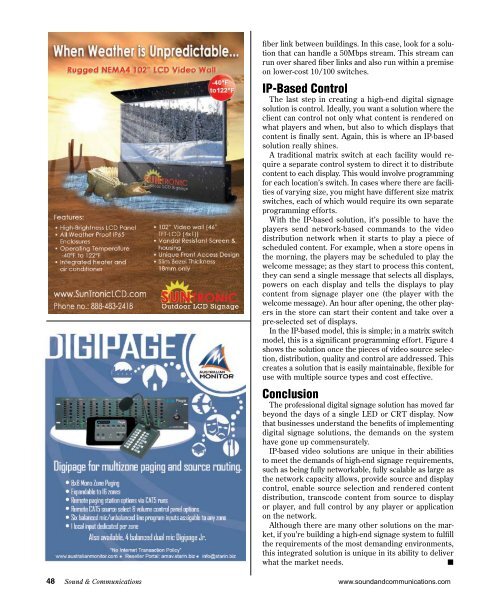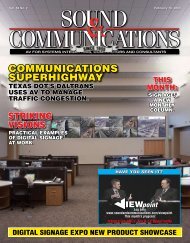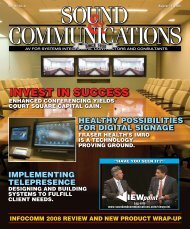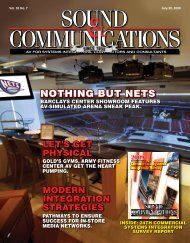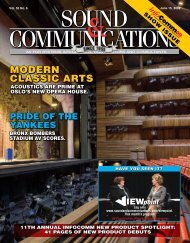Sound and Communications - July 2008 Issue
Sound and Communications - July 2008 Issue
Sound and Communications - July 2008 Issue
- No tags were found...
Create successful ePaper yourself
Turn your PDF publications into a flip-book with our unique Google optimized e-Paper software.
fiber link between buildings. In this case, look for a solutionthat can h<strong>and</strong>le a 50Mbps stream. This stream canrun over shared fiber links <strong>and</strong> also run within a premiseon lower-cost 10/100 switches.IP-Based ControlThe last step in creating a high-end digital signagesolution is control. Ideally, you want a solution where theclient can control not only what content is rendered onwhat players <strong>and</strong> when, but also to which displays thatcontent is finally sent. Again, this is where an IP-basedsolution really shines.A traditional matrix switch at each facility would requirea separate control system to direct it to distributecontent to each display. This would involve programmingfor each location’s switch. In cases where there are facilitiesof varying size, you might have different size matrixswitches, each of which would require its own separateprogramming efforts.With the IP-based solution, it’s possible to have theplayers send network-based comm<strong>and</strong>s to the videodistribution network when it starts to play a piece ofscheduled content. For example, when a store opens inthe morning, the players may be scheduled to play thewelcome message; as they start to process this content,they can send a single message that selects all displays,powers on each display <strong>and</strong> tells the displays to playcontent from signage player one (the player with thewelcome message). An hour after opening, the other playersin the store can start their content <strong>and</strong> take over apre-selected set of displays.In the IP-based model, this is simple; in a matrix switchmodel, this is a significant programming effort. Figure 4shows the solution once the pieces of video source selection,distribution, quality <strong>and</strong> control are addressed. Thiscreates a solution that is easily maintainable, flexible foruse with multiple source types <strong>and</strong> cost effective.ConclusionThe professional digital signage solution has moved farbeyond the days of a single LED or CRT display. Nowthat businesses underst<strong>and</strong> the benefits of implementingdigital signage solutions, the dem<strong>and</strong>s on the systemhave gone up commensurately.IP-based video solutions are unique in their abilitiesto meet the dem<strong>and</strong>s of high-end signage requirements,such as being fully networkable, fully scalable as large asthe network capacity allows, provide source <strong>and</strong> displaycontrol, enable source selection <strong>and</strong> rendered contentdistribution, transcode content from source to displayor player, <strong>and</strong> full control by any player or applicationon the network.Although there are many other solutions on the market,if you’re building a high-end signage system to fulfillthe requirements of the most dem<strong>and</strong>ing environments,this integrated solution is unique in its ability to deliverwhat the market needs.n48 <strong>Sound</strong> & <strong>Communications</strong>www.sound<strong>and</strong>communications.com


